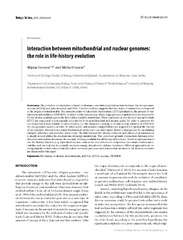Приказ основних података о документу
Interaction between mitochondrial and nuclear genomes: the role in life-history evolution
| dc.creator | Stojković, Biljana | |
| dc.creator | Đorđević, Mirko | |
| dc.date.accessioned | 2017-11-23T11:29:05Z | |
| dc.date.available | 2017-11-23T11:29:05Z | |
| dc.date.issued | 2017 | |
| dc.identifier.issn | 2334-6590 | |
| dc.identifier.uri | https://ojs.pmf.uns.ac.rs/index.php/dbe_serbica/article/view/6493 | |
| dc.identifier.uri | https://radar.ibiss.bg.ac.rs/handle/123456789/2816 | |
| dc.description.abstract | The evolution of eukaryotes is based on dynamic coevolutionary interactions between the two genomes, nuclear (nDNA) and mitochondrial (mtDNA). Current evidence suggests that the origin of eukaryotes corresponds to the origin of mitochondria. The primary center of adenosine triphosphate (ATP) production through the process of oxidative phosphorylation (OXPHOS), which is based on the functioning of four large protein complexes that are responsible for the proton gradient across the inner mitochondrial membrane. These complexes in the electron transport chain (ETC) are composed of polypeptides encoded by both mitochondrial and nuclear genes. In order to preserve the uncompromised functionality of mitochondria, i.e. the adequate coupling of all interacting subunits in OXPHOS, the two genomes had to coevolve. In other words, mitonuclear compatibilities are required for optimal life-history of an organism because even minor biochemical inefficiency can have major fitness consequences by modulating energetic efficiency and oxidative stress levels. The link between life-history evolution and mitonuclear interactions is deeply rooted within the mechanisms of energy metabolism. The coevolved epistatic interactions between mitochondria and nucleus determine the amount of energy available for all biological functions. Selective optimization of one life-history function (e.g. reproduction) may come at the cost of reduced competence for somatic maintenance, viability and survival due to mutually exclusive energy allocation to distinct functions. Different approaches in investigating the central roles of mitochondrial metabolic processes and mitonuclear epistasis in life-history evolution are discussed in this paper. | en |
| dc.rights | openAccess | |
| dc.rights.uri | https://creativecommons.org/licenses/by/4.0/ | |
| dc.source | Biologia Serbica | |
| dc.subject | Life-history evolution | |
| dc.subject | Mitochondria | |
| dc.subject | mtDNA | |
| dc.subject | nDNA | |
| dc.subject | Nucleus | |
| dc.subject | OXPHOS | |
| dc.title | Interaction between mitochondrial and nuclear genomes: the role in life-history evolution | en |
| dc.type | article | |
| dc.rights.license | BY | |
| dcterms.abstract | Ђорђевић, Мирко; Стојковић, Биљана; | |
| dc.rights.holder | © Department of Biology and Ecology, Faculty of Sciences, University of Novi Sad | |
| dc.citation.issue | 1 | |
| dc.citation.volume | 39 | |
| dc.description.other | Biologia Serbica (2017), 39(1): 32-40 | |
| dc.identifier.doi | 10.5281/zenodo.826619 | |
| dc.citation.apa | Stojković, B., & Đorđević, M. (2017). Interaction between mitochondrial and nuclear genomes: the role in life-history evolution. Biologia Serbica, 39(1), 32–40. | |
| dc.citation.vancouver | Stojković B, Đorđević M. Interaction between mitochondrial and nuclear genomes: the role in life-history evolution. Biol Serbica. 2017;39(1):32–40. | |
| dc.citation.spage | 32 | |
| dc.citation.epage | 40 | |
| dc.type.version | publishedVersion | en |
| dc.identifier.fulltext | https://radar.ibiss.bg.ac.rs/bitstream/id/3342/bitstream_3342.pdf | |
| dc.citation.rank | M53 |

